Läser in alla nyheter. Det tar en liten stund...
-
The Swedish Migration Agency answers: How long does it take to get a work permit?
The Swedish Migration Agency is working to streamline the examination of work permits and make the process more predictable. But how long are the processing times? And why do you have to wait for a permit?
Most people who apply for a permit to come to Sweden and work receive a decision about their application within four months. Yet some cases take longer, and the agency has taken a number of measures to address this. The aim is that no cases should take longer than four months, which corresponds to the processing time required under the regulations.
A few years ago, the Swedish Migration Agency introduced a fast track for companies that meet certain requirements – so-called “certified companies”. With the fast track, processing time should be predictable and short; ten days is the goal the agency set several years ago. The proportion of certified companies has grown, and a review of the requirements for certification is underway, with the aim of enabling the agency to cope with a demanding situation: more incoming cases, altered legislation and new mandates from the Government.
This article will answer some frequently asked questions about the examination of work permit applications and their processing times. Unless otherwise stated, the figures are based on cases decided in 2022.
How long are the processing times for obtaining a work permit?
In 2022, processing times grew longer in some categories. At present, applicants may even need to wait over a year for a decision. But just because a few people have to wait a long time doesn’t mean that everyone has to. There is a big difference between different types of cases.
First time or extension
Firstly, there is a big difference between people applying for a work permit for the first time and those applying for an extended work permit. Getting a decision on an extension takes significantly longer – today, the average processing time in an extension case is 220 days, while a first-time case takes about half as long – an average of 116 days, i.e., just under four months. 70 per cent of first-time cases take less than four months, while more than 60 per cent of extension cases are decided after more than four months.
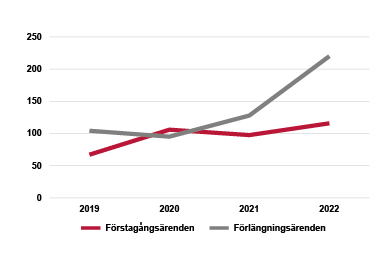
The average time in days – increase between 2019 and 2022. Extension cases have increased more than first-time applications. Source: Swedish Migration Agency
Certified or not
Secondly, cases that fall into the “fast track” category are a different story. When it comes to certified cases, for years the average processing time for first-time cases; more than 80 per cent of cases were resolved within a month. In 2022, the average time grew to 58 days, with approximately 30 per cent of certified companies’ cases resolved within a month. In 2022, the average processing time of first-time cases for non-certified companies was 144 days.
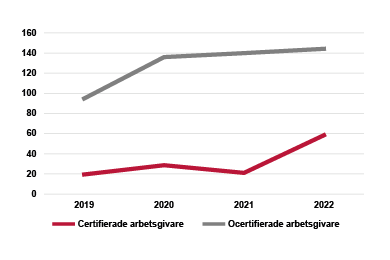
This is how the average time for certified and uncertified employers has increased between 2019 and 2022. Source: the Swedish Migration Agency
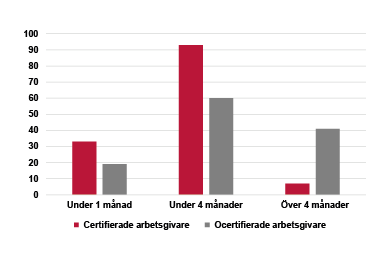
How many had to wait how long? The diagram shows the percentage of applicants who had their application decided within a certain time, depending on whether they had a certified or non-certified employer. The figures refer to first-time cases in 2022. Source: the Swedish Migration Agency
Average or median
Thirdly, a distinction can be made between “median” and “average” processing times. The median time for first-time applications was 52 days for cases decided in 2022, while the average time was 116 days. For extension cases, the median time was 148 days, while the average time was 220 days. The median processing times are generally shorter than the average processing times. This can be seen in the processing times for work permits. If there are a large number of cases with long processing times, this can lead to long average processing times. In such cases, it may be a good idea to also look at the median measurement to provide a more nuanced picture of how processing times have developed.
Conclusion: different cases have different processing times
In other words, when applying for a work permit, the category to which the case belongs makes a big difference. The fastest way to get a decision is to submit a first-time work permit application for a certified company. It takes the longest time for non-certified companies to extend a permit; the average time in 2022 was 335 days, which means that there is a high risk that you will have to wait more than a year for a decision.
Last year, the processing time for most of the applicants (almost three out of four applicants) who received a work permit for the first time in Sweden was less than four months. The corresponding period for extension applications was significantly longer.
Why have processing times gotten longer?
However, you calculate over time, 2022 stands out as a year with growing processing times. And this is despite the fact that the Swedish Migration Agency has long been working to streamline and speed up the examination of work permit cases. There are several explanations for the longer processing times – and the Swedish Migration Agency has been able to influence some of these aspects, but not others.
- Manpower. When Russia invaded Ukraine, many people sought protection in Sweden, which meant that the agency had to reallocate its examination resources. Many agency employees working with work permits had to prioritise Ukrainian applications for residence permits.
- More cases. In 2022, 105,000 work permit cases were received by the Swedish Migration Agency. This was more than ever before.
- A new law from 1 July 2022. The complexity of work permits has increased with new legislation. This not only affects productivity, but also creates obstacles in the digitalisation that is underway at the agency to streamline the examination process.
- Passports must now be in original form. In order to meet the requirements for identity checks, the Swedish Migration Agency introduced new procedures last year that mean that an applicant must present their original passport when applying for a permit. This is expected to have an impact in the form of longer processing times for those who apply for a work permit for the first time, because they must now go to an embassy and present their passport in order to be granted a residence permit.
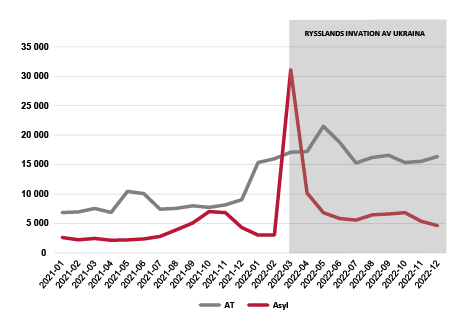
Applications received 2021-2022. The number of work permit cases received has increased over the past two years. Within the asylum process, it is Russia's invasion of Ukraine in particular that has affected the number of cases received. Source: the Swedish Migration Agency
What is the Swedish Migration Agency doing now?
To improve the processing times in work permit cases, the Swedish Migration Agency has taken a number of measures. The single most important measure is to increase the number of people working with work permit cases, and last year the agency increased its examination team from 200 to 300 people.
In addition, a focus group that includes agency employees who work with examination has been set up to review the entire system and identify areas where improvements can be made. Digitalisation is also an important component in making the application process faster, smoother and more accessible for applicants.
At the same time, the Swedish Migration Agency is cooperating with the business community to take the measures that are actually requested. Among other things, there is an external reference group in which a dialogue is being conducted about the strained situation surrounding work permits and various options going forward.
-
The Swedish Migration Agency answers: how many people go back to their country of origin?
In this section of “The Swedish Migration Agency answers”, we highlight return and repatriation – two areas that are often confused but which are two completely different things.
What are the different ways in which people can return to their country of origin or be repatriated?
Let’s start by clarifying a first, fundamental question: what is the difference between return and repatriation?
In simple terms, returning is when a person has received a refusal of entry or expulsion decision, which means that they are obliged to leave Sweden and the Schengen area. If the person does not comply with the decision, the case can be handed over to the police. There can be two grounds for such a transfer; either coercion/force is needed to enforce the decision, or the person is hiding and a search must be conducted to find them. When the person in question has left the country or the case is handed over to the police for enforcement, the Swedish Migration Agency closes the return case. We explain the concept of enforcement further down.
Repatriation is when a person who has a valid residence permit chooses to leave Sweden and move back to their country of origin or to another country where the person has the right to stay.
What happens after the decision?
Depending on whether someone has received a refusal of entry or expulsion decision, they have different amounts of time to leave Sweden. In the case of refusal of entry, they have two weeks to leave. In the case of expulsion, they have four. If there are special grounds, they may be given a longer period of time to leave Sweden. The time starts counting down from the date on which the decision entered into legal force – i.e., as soon as it is no longer possible to lodge an appeal. The Swedish Migration Agency is responsible for holding return interviews with the returnee to provide support and information, e.g., about how the return will be carried out and how the agency can assist them.
Once a person with a return decision has travelled out of Sweden and the Schengen area, the decision is deemed to have been enforced – but just because the Swedish Migration Agency has made a refusal of entry or expulsion decision does not always mean that the agency can enforce it. In some cases, there may be no practical conditions for a person to be able to return to their country of origin. In particular, these are situations where:
- The person who must return is a child without a legal guardian, and it has been impossible to arrange for the child’s reception in their country of origin – in which case an expulsion may not be carried out even if such a decision has been made.
- The person does not wish to help with contribute to obtaining a travel document and the agency cannot help with it. The agency may be unable to assist in obtaining a travel document because there is insufficient information on the person in the case or because there is no re-admission agreement with the country in question: i.e., a structured cooperation agreement with the receiving country in the event of a return.
What can the Swedish Migration Agency do?
A common misconception is that the Swedish Migration Agency expels people by force (deports them). This is incorrect. The Swedish Migration Agency only works with voluntary returns and cannot force a person to return to their country of origin. On the other hand, the Swedish Migration Agency can decide to take a person into detention and then, if the person continues to refuse to comply with their return decision, the agency can hand over the case to the Swedish Police Authority, which has the right to use force if necessary. However, it is important to point out that enforcement must be implemented in as humane and legally secure a manner as possible.
Return support
In some cases, a person who has received a refusal of entry or expulsion decision and must return to their country of origin is entitled to financial support from the Swedish Migration Agency. This is called “reestablishment support” and aims to facilitate reestablishment in the person’s country of origin. Only nationals of certain countries – including Afghanistan, Eritrea, Iraq, Palestine and Somalia – are eligible for this aid.
The size of the reestablishment support depends on how old the applicant is – it is SEK 30,000 for those aged 18 and older and SEK 15,000 for minors. The support cannot exceed SEK 75,000 per family.
Repatriation support
In some cases, the Swedish Migration Agency can pay travel grants to people who want to be repatriated to their country of origin. It may do so if someone has a residence permit:
- as a refugee
- as a person in need of subsidiary protection
- on the grounds of exceptionally distressing circumstances, or
- as a quota refugee.
Anyone who wants to repatriate can receive a cash grant in addition to a grant for the actual journey. How much you can receive depends on how old you are and how many people are in your family. The agency grants a maximum of SEK 10,000 for each adult and SEK 5,000 for each underage child. A family cannot receive more than SEK 40,000 in cash.
A total of 33 applications for repatriation grants were received last year, of which two were granted.
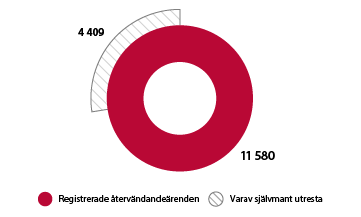
In 2022, a total of 11,580 return cases were registered, the chart shows how many of these that have returned voluntarily.
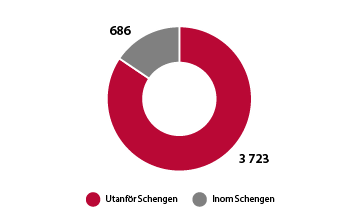
All those who return do not depart according to their decision (to leave Schengen) but instead travel to another country within Schengen. The diagram shows how the distribution has looked for the return cases closed in 2022.
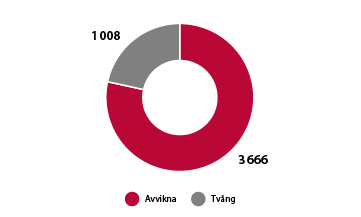
Return cases that were handed over to the police in 2022, either because force was needed or because the person was absconded.
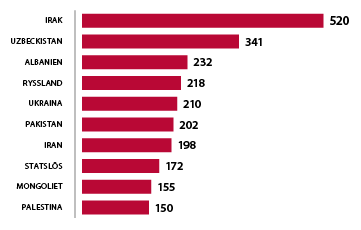
Which citizenships were most common among those who returned voluntarily in 2022? The diagram shows the ten largest nationalities.
How many people returned in 2022
In 2022, 11,580 return cases were registered. A return case is registered by the Swedish Migration Agency as soon as the refusal of entry or expulsion decision becomes enforceable, which usually happens when it enters into legal force.
Of these 11,580 decisions, 4,409 individuals are currently registered as having voluntarily left the country – 3,723 people have travelled according to their decision and left Schengen, while the rest have travelled to another country within the Schengen area.
Over the past few years, the number of registered return cases has decreased; in 2020, 18,523 cases were registered, while in 2021, 13,782 were registered.
In terms of the number of people who have actually emigrated, the Swedish Migration Agency registered 6,800 voluntary returns in 2020 and 6,300 in 2021.
During the year, the Swedish Migration Agency handed 4,674 cases over to the police – 3,666 because the person had absconded and 1,008 because it was necessary to use coercion/force.
In 2022, Iraq, Uzbekistan, Albania, Russia and Ukraine accounted for the five largest citizenships for all voluntary emigration.
What’s next?
The Swedish Migration Agency has a number of mandates from the Government concerning return and repatriation. These issues will thus continue to be a focus throughout 2023.
Help increase voluntary returns
The Swedish Migration Agency must create the conditions for more voluntary returns among people who receive a refusal of entry or expulsion decision in their asylum or permit case. This also applies to people who receive a decision on refusal of entry with immediate effect – for example, because an asylum application is deemed to be manifestly unfounded and it is also obvious that a residence permit should not be granted on any other grounds.
Collaboration to streamline return work
Another mandate from the Government calls upon the Swedish Migration Agency, together with the Swedish Police Authority and the Swedish Tax Agency, to review how these authorities should work together to contribute to more effective return work.
The number of enforcements will increase by 50 per cent
The Swedish Migration Agency and the Swedish Police Authority have been tasked with jointly increasing the number of enforced refusal of entry and deportation decisions by 50 per cent in 2023 compared to 2021 – in numbers, that’s just under 9,000 people.
Increase knowledge to increase returns
The Swedish Migration Agency will provide more knowledge about what support is offered to people who return to their country of origin voluntarily – with the aim of getting more people to do so. To this end, a working group at the Swedish Migration Agency has been appointed to move forward with this new mandate.
A few of the figures in this text were updated after publication.
-
The Swedish Migration Agency answers: how do you get Swedish citizenship?
In connection with Sweden’s National Day, the Swedish Migration Agency wishes to draw attention to the issue of citizenship and explain what happens when you become a Swedish citizen. This has long been one of the agency’s biggest topics – and this article will answer some of the most frequently asked questions.
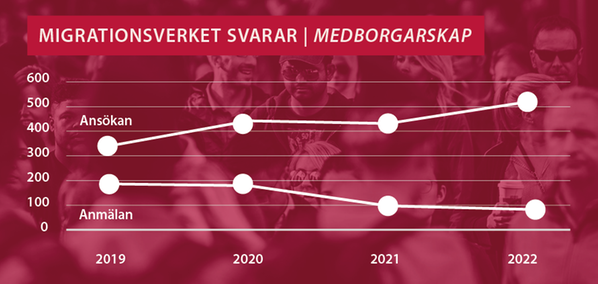
The chart shows the number of applications (upper line) and the number notifications for Swedish citizenship yearly 2019–2022.
How do you become a Swedish citizen?
There are different ways to become a Swedish citizen: by application, notification, or automatically by birth or adoption. A child becomes a Swedish citizen at birth if one of their parents is a Swedish citizen, but a child who is adopted by a Swedish parent also gains citizenship.
In this article, we will focus on the people who become Swedish citizens through an application or notification – as these are the most common approaches that account for the largest number of citizenship cases each year.
The requirements for becoming a Swedish citizen by application can be found in the Swedish Citizenship Act, which states that you must:
- Be at least 18 years old
- Be able to prove your identity
- Have lived in Sweden for a certain amount of time
- Have lived an orderly life
- Have a permanent residence permit, or have right of residence or a residence card, or have residence status
Having lived an orderly life means that you must not have debts or have committed crimes in Sweden. The Swedish Migration Agency collects information from the Swedish Enforcement Authority, the Swedish Police Authority, and the Swedish Security Service. If you have debts or have committed crimes, you can still become a Swedish citizen – but a certain amount of time must have passed after the debts have been paid and the sentences have been served.
A notification to become a Swedish citizen is a simplified procedure compared to application. Not everyone can submit a notification; only underage children, young adults between the ages of 18 and 21 and Nordic citizens can do so.
There are different types of notifications of Swedish citizenship and thus different requirements – and exemptions from the requirements. Here we limit ourselves to notification under Section 7 of the Swedish Citizenship Act, which applies to underage children. Such a notification can be submitted if the child:
- Has a permanent residence permit, right of residence, a residence card, or residence status in Sweden
- Has lived in Sweden for at least three years, or two years if the child is stateless
- Is under 18 years old
For this group, there is no requirement for proof of identity or having lived an orderly life, as there is in the case of an application.
How many people became Swedish citizens in 2022
Last year, approximately 86,000 cases were received to become a Swedish citizen. During the same period, almost 92,000 cases were decided. These figures indicate that the agency decided more cases than were received.
The average processing time for decided applications was 519 days, and 84 per cent of applications were granted. As regards notifications, the average processing time was 82 days and the approval rate was 80%. In terms of numbers, nearly 90,000 people became Swedish citizens in 2022: 75,000 by application and 15,000 by notification.
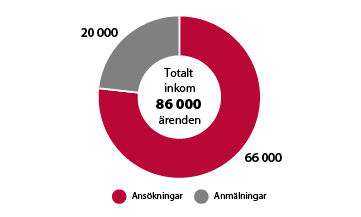
The diagram shows how the distribution looked between received applications and notifications about citizenship in 2022.
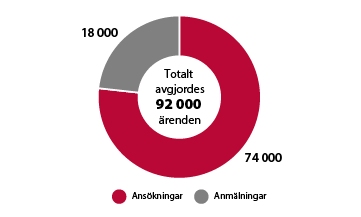
The diagram shows how the distribution looked between decided applications and notifications about citizenship in 2022.
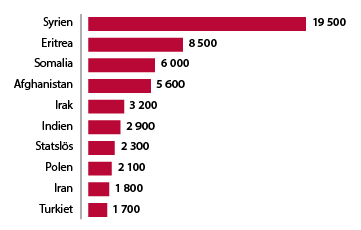
The ten most common nationalities that received Swedish citizenship in 2022.
At the end of the year, there were just over 88,000 open applications and just over 6,000 notifications.
Of the people granted Swedish citizenship in 2022, Syria, Eritrea, Somalia, Afghanistan and Iraq accounted for the five largest citizenships.
How long does it take to get a decision?
For several years now, the Swedish Migration Agency has had long processing times for applications for citizenship. This is mainly due to the large number of applications that have been received in a short period of time – which can be linked to the large influx of refugees in 2015, when 163,000 people applied for asylum in Sweden, of which just over 95,000 were granted residence permits.
Of the citizenship applications that have been decided in the past month, 75 per cent have received a decision within 36 months. The remaining 25 per cent have had to wait longer than that. Of the notifications that have been decided in the past month, 75 per cent have received a decision within ten months.
Why does it take so long?
There are several factors that affect how long you have to wait for a decision. Here are some examples:
- Whether an investigation is needed – all new cases undergo a so-called “screening” process. A categorisation is made based on how much investigation the case demands. A case that requires less investigation can often be resolved within six months.
- Checks with other authorities – The Swedish Migration Agency is dependent on information from other authorities such as the Swedish Police Authority, the Swedish Security Service, and the Swedish Enforcement Authority. Depending on the applicant’s background, the register check may take different lengths of time – something that the Swedish Migration Agency cannot influence.
- Request for a decision – according to Section 12 of the Administrative Procedure Act, you can request that a case be decided when you have been waiting for a decision for at least six months. The fact that many applicants submit such a request takes a lot of resources away from normal examination, which leads to longer processing times in general.
What the law says
When we talk about processing times, we are usually talking about statutory times – that is, the length of time that laws and ordinances say that an authority has to make a decision. When it comes to applying for Swedish citizenship, there is no such time limit. However, the Administrative Procedure Act applies: they must be handled as simply, quickly and cost-effectively as possible, and it must be done in a legally secure manner.
What is the Swedish Migration Agency doing to shorten the processing times?
The Swedish Migration Agency is constantly working to improve the situation and shorten the processing times. For example, the agency’s operations dealing with citizenship matters have been expanded from one locality to two. Today, almost 200 people work with the processing of these cases – a number that will increase further in coming years.
Another measure that has been taken is that the agency has asked for a temporary exemption from Section 12 of the Administrative Procedure Act, i.e., the possibility of submitting a request for a decision. The aim is to create a pause in the handling of so-called “delay cases” in order to shorten processing times and reduce the number of cases waiting in line.
Digitalisation is also an important part of the work to achieve shorter processing times. For example, the agency can make fully automated decisions in cases or carry out automatic checks and additions.
A Swedish citizenship cannot be revoked
The question of whether or not a Swedish citizenship can be revoked often sparks debate. Swedish citizenship is protected by one of our four constitutional laws and is therefore irrevocable. This applies even if you have committed a crime or have otherwise failed to live an orderly life.
Difference between revocation and loss
It is common for revocation to be confused with loss of citizenship, which is something else. A Swedish citizen loses their Swedish citizenship on their twenty-second birthday if they were born abroad, have never lived in Sweden, and have never been here under circumstances that show that they have an affinity with the country.
Current policy proposals
The Government is working on proposals from the inquiry entitled Altered rules in the Citizenship Act (in Swedish)
 External link, opens in new window., and has now also presented its efforts to implement new inquiries with the aim of strengthening Swedish citizenship, which it believes can be done through stricter requirements. In addition to investigating the introduction of requirements for knowledge of Swedish and civics, the Government is investigating the possibility of starting an inquiry into the circumstances that could form the basis for the revocation of citizenship.
External link, opens in new window., and has now also presented its efforts to implement new inquiries with the aim of strengthening Swedish citizenship, which it believes can be done through stricter requirements. In addition to investigating the introduction of requirements for knowledge of Swedish and civics, the Government is investigating the possibility of starting an inquiry into the circumstances that could form the basis for the revocation of citizenship.The Government also believes that there is a need for a more uniform regulation for applying for and declaring citizenship, as there is currently no requirement for an honest lifestyle in a notification case, as there is in an application case.
- Be at least 18 years old
-
Pop-up passport controls in the USA and Canada this summer
In July 2023, visa exempt students and work permit applicants will have the opportunity to have their passports checked at five different locations in the USA and Canada.
Since November 1, 2022, all individuals seeking residence permit in Sweden must present their passport in person at an embassy in order to be granted a favourable decision.
This change was particularly noticeable for visa exempt applicants who previously could receive the permit and enter Sweden without visiting the embassy. Since then, the Swedish government has commissioned the Migration Agency to simplify the procedure for this group and limit the inconvenience of travelling far to visit an embassy.
One of the measures taken by the Swedish Migration Agency is to send personnel to five different locations in North America in July this summer.
“We are making this effort in parallel with the evaluation of other possible solutions,” explains Oskar Ekblad, Head of Foreign operations.
The locations have been selected with regard to when and where the demand is greatest, as well as the longest travelling distance to an embassy. Many applications from students coincide with the start of the terms, and even though employees do not apply with the same regularity, they are also welcome to visit the pop-up passport checks.
“We have chosen USA and Canada because these are places of vast distances and a large population of students who might benefit from this effort,” says Oskar Ekblad.
Personnel from the Migration Agency and the embassies will form pop-up passport controls in place for students and employees. They will visit easily accessible urban places, mainly on the campuses of large universities (see below for details).
“There is no need to book an appointment in advance. We believe we will be able to help everybody who turns up given that they don’t all arrive last minute,” says Oskar Ekblad.
The Swedish Migration Agency will assess the pop-up control effort and continue to evaluate other possible solutions, such as digital solutions or an independent service provider, with regard to legal frames and information security.
Facts about the pop-up passport controls
The pop-up passport controls are available to you who
- live in the USA or Canada,
- have applied for a residence permit for the purpose of studying or working in Sweden,
- can enter Sweden without a visa.
Locations and dates
3 July, the Swedish consulate in Vancouver, Canada
4 July, Vancouver, British Columbia. University of British Columbia, Canada
5–6 July, San Francisco, California. University of California Berkeley
7 July, Los Angeles, California. University of California Los Angeles
10–11 July, Houston, Texas. Rice University
12 July, Chicaco, Illinois. DePaul University
13 July, Chicaco, Illinois. Honorary Consulate of Sweden
No interviews at the pop-up stations
Applicants who need a visa or a residence permit card in order to enter Sweden cannot have their passport checked at the pop-up stations. You need to visit the Embassy of Sweden in Washington, DC, or Ottawa, in order to provide fingerprints and be photographed. The same goes for you who need to be interviewed, for example if you have applied for a residence permit to move to a family member in Sweden. Contact the Embassy of Sweden in Ottawa or in Washington, DC, to find out how to book an appointment.
-
The introduction of the new work permit model is starting
The report to promote highly qualified labour immigration has been submitted to the Government – and now the work of introducing the new model begins.
“We’ve been working on our mandate to implement a new model for work permits, which will make it easier to recruit foreign workers to Sweden, throughout the past year. Now we’re zeroing in on all parts of our organisation to make the transition as predictable and easy as possible for all parties,” says the Swedish Migration Agency’s Fredrik Bengtsson, Regional Director for Region South Sweden.
In the budget and policy specification for 2023, the Swedish Migration Agency received a mandate to promote highly qualified labour immigration to Sweden. The aim is to ensure that employers in highly qualified professional sectors get the labour they need, when they need it, thereby contributing to a competitive Sweden. In order to fulfil this task and to overhaul the entire work permit process, the Swedish Migration Agency has decided to introduce a new model for handling work permit cases and to establish international recruitment units.
The new model puts particular focus on:
- Better service
- 30-day processing time for a complete application
- Easier to apply
“We’re going to have special service teams that will support companies and employers in the establishment of larger companies. We’re well aware that employers, especially in major expansion and establishment phases, have a broad need for labour from third countries. Through our strengthened service organisation, we will come together and work closely with those employers,” says Fredrik Bengtsson.
In cooperation with the employer organisations, the Swedish Migration Agency is also developing an improved e-service.
“It should be easy to apply for a work permit. The processing needs to be predictable and transparent. Our goal is to develop the e-service and the application procedure, thus increasing the proportion of complete applications.”
New model in place at the turn of the year 2023/2024
With the changes in the work permit process, the Swedish Migration Agency has committed to a 30-day processing time for highly qualified workers.
“A processing time of 30 days is in line with an international comparison of how long similar permit processes take in other countries. We anticipate that we’ll be ready to launch the entire model at the beginning of next year,” says Fredrik Bengtsson.
Read more
Changes related to work permits
-
The Swedish Migration Agency answers: how we work to revoke permits
When and why can a residence permit be revoked? This possibility can be raised for different reasons, depending on the type of residence permit you have – in this part of “The Swedish Migration Agency answers”, we explain how we work with revocations.
A residence permit is granted by a decision from the Swedish Migration Agency if certain specific requirements are met. If information later emerges that means that someone no longer meets the requirements, the Swedish Migration Agency may decide to revoke their residence permit – we call this “revocation”. The possibility of revocation may not only arise for people who have a residence permit to live in Sweden, but can also affect those with a status declaration or entry visa.*
In which cases can the Swedish Migration Agency decide to issue a revocation?
The Swedish Migration Agency receives tips and information in various forms that may lead to us to need to investigate whether a residence permit, status declaration or visa should be revoked. For example, this could be a tip from a private individual, a follow-up check carried out by the Swedish Migration Agency, or we could become aware of changes in a person’s population registration, such as changes in personal data or deregistration.
A residence permit can be revoked for several different reasons. These are established in the Aliens Act. As a rule, a permit can be revoked if the applicant provided incorrect information in their application or did not tell us about something of significance to their residence permit. The permit can also be revoked if the conditions for the permit are no longer met, for example if someone was granted a residence permit for studies but is no longer studying. Below we describe some other examples in a little more detail.
Revocation due to incorrect information
The Swedish Migration Agency may revoke a residence permit an applicant has deliberately lied or withheld something that was important for their residence permit.
Revocation on special grounds
In some cases, the Swedish Migration Agency may revoke a residence permit on special grounds. This may only happen if the applicant has not yet entered Sweden. It may be that the conditions for someone’s residence permit are no longer met, for example that the connection they are moving to Sweden to join no longer exists.
Revocation because someone has moved away from Sweden
If someone has a permanent residence permit in Sweden but is no longer resident here, or has been abroad for a long time for some other reason, the Swedish Migration Agency will revoke their permit.
In some cases, such an individual can still keep their permanent residence permit, in which case they must notify the Swedish Migration Agency in advance. In that case, the residence permit may be revoked no sooner than two years after the end of the person’s residence in Sweden.
A status declaration may be revoked without the residence permit being affected
If someone has been granted a residence permit in Sweden on the grounds of asylum, they will first have received a status declaration: a refugee status declaration or a subsidiary protection status declaration. If the Swedish Migration Agency decides to revoke their status declaration, this does not automatically mean that their residence permit will also be revoked. This means a person’s status declaration may be revoked without affecting their residence permit.
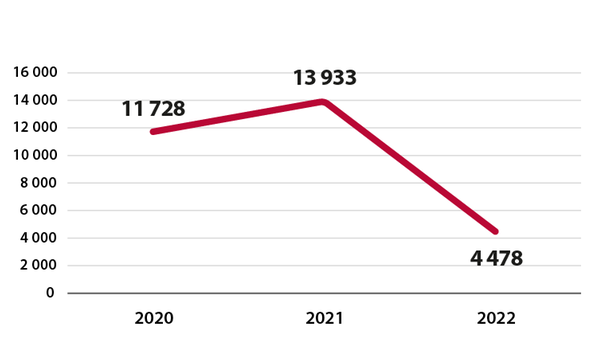
The chart shows the number of residence permits revoked each year 2020–2022. The significant difference between 2020/21 and 2022 is due to an administrative effort made in 2020, which also spilled over into 2021
Revocation in numbers
Below, we show use numbers to provide a picture of our revocation work over the past three years.
How many revocations we made
In 2020, a total of 11,728 residence permits and 291 status declarations were revoked. Not everyone who has a residence permit has a status declaration, so there is a significant difference between these figures.
The number of revocations increased slightly in 2021, when the Swedish Migration Agency revoked 13,933 residence permits and 371 status declarations.
The figures from last year instead show a difference in the other direction, as the number of revoked residence permits decreased to 4,478. However, when it comes to status declarations, the figure remained almost unchanged: 370 revocations.
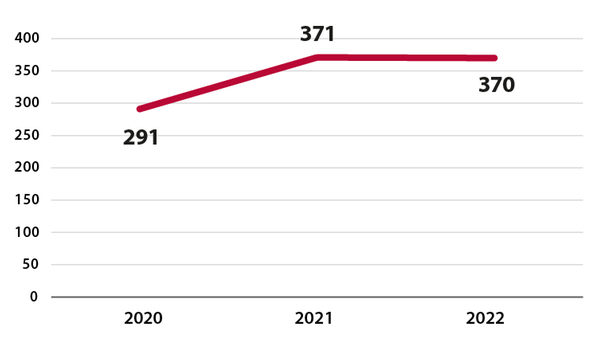
The chart shows the number of status declarations revoked each year 2020–2022.
The reason why the number of revoked residence permits was higher during the first two years is that in 2020, the Swedish Migration Agency produced data on how many people were registered as emigrated by the Swedish Tax Agency – which resulted in the revocation of permanent residence permits for a large portion of these people. This had not previously been done, so the work spilled over into the number of revocations in 2021 as well.
The most common permits that are revoked
When it comes to the type of permits that are revoked, the situation has remained more or less the same over the past three years. In 2020 and 2021, residence permits on the basis of family ties, work and asylum accounted for most of the revocations, with family ties at the top, followed by the other two groups. In 2022, the numbers looked almost the same – but here, most revoked permits were work permits instead of permits issued based on family ties.
What’s happening now and in the future
The work with the revocation of residence permits is now a more prioritised issue than before at the Swedish Migration Agency. The prioritisation is part of the agency’s work to implement the Government’s policy for change in the area of migration.
Mandate from the Government
One of the Swedish Migration Agency’s mandates from the Government is to take measures to strengthen its work with the revocation of residence permits. The purpose of the mandate is to ensure that the system of regulated immigration is not abused.
The Government has also instructed the agency to review whether automated systems and other administrative support can be used to a greater extent and thus make the work more efficient.
At the end of June, the Swedish Migration Agency submitted a final report on the mandate to the Government.
Click here to read the Government mandate in its entirety: Mandate to strengthen the work with cases concerning the revocation of residence and work permits (in Swedish)
 External link, opens in new window.
External link, opens in new window.Cooperation with the Swedish Tax Agency
The Swedish Migration Agency is currently collaborating with the Swedish Tax Agency on the automatic transfer of information regarding people with permanent residence permits who have been registered as emigrants. Looking ahead, it is likely that similar automation to that used for people who have a permanent residence permit could be developed to also include people with temporary residence permits.
The Swedish National Audit Office is conducting an audit
The Swedish National Audit Office is currently conducting an audit of the system for revoking residence permits, with the aim of checking whether the system works effectively. The reason for the audit is that shortcomings in the system can have consequences, such as incorrect payments from the welfare systems. It can also affect crime prevention work. The results of the audit are slated for publication in November 2023.
* A person who has applied for a residence permit in Sweden on the grounds that they need protection will receive a status declaration if they fall under one of the definitions in the Aliens Act. An entry visa is what is colloquially known simply as a “visa” . This is issued for temporary visits to Sweden.
-
The Swedish Migration Agency answers:
Who comes to Sweden – and why?Around 190,000 people applied for a residence permit in Sweden last year, and 132,000 people were granted permission to be here. These included refugees, employees, students and close relatives of people who already live here, from all over the world. In this article, we will answer questions about who comes to Sweden, why, and how migration to Sweden developed between 2013 and 2022.*
Over the past decade, migration to Sweden has been characterised by dramatic changes. Over the course of just two years, 2014–2015, a quarter of a million asylum seekers came to Sweden, which led to temporary border controls and stricter migration legislation.
After that, the number of asylum seekers fell sharply. Sweden has gone from receiving around 10 percent of the EU’s asylum seekers in the years before 2016 to less than 1.5 percent so far this year.
An exception to the trend of fewer people seeking protection here occurred last year, following Russia’s full-scale invasion of Ukraine. Millions of Ukrainians then sought protection in Europe, the EU activated the Temporary Protection Directive, and about 50,000 people received protection in Sweden.
In parallel with major fluctuations in migration policy, the number of people who came here to work increased during the period 2013–2022. In 2023, about the same number of people have applied for protection in Sweden as for work permits.
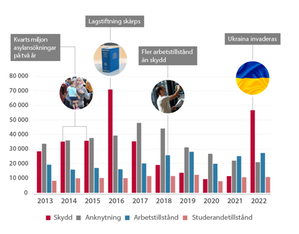 Zoom image
Zoom imageNumber of residence permits granted per category 2013–2022. The bars represent protection (red), family reunion (grey) work (blue), student (pink). The pictures (left-right: A quarter of a million asylum seekers to Sweden in two years, Restrictive legislation, More work permits than protection permits granted, Invasion of Ukraine. Press to enlarge.
Over the past decade, more than half a million people have sought protection here
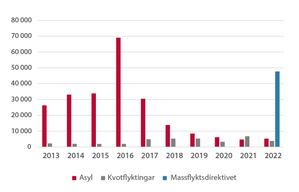 Zoom image
Zoom imageNumber of residence permits granted for protection per category 2013–2022. The bars represent asylum protection (red), UN quota refugee (grey), EU Temporary Protection directive (blue). Press to enlarge.
Between 2013 and 2022, more than half a million (550,630) first-time applications for protection were submitted in Sweden. This figure also includes quota refugees and people from Ukraine who have received protection under the Temporary Protection Directive. More than half the applicants (328,632) were granted protection in Sweden.
Here it should be pointed out that the Swedish Migration Agency only reports granted permits, not the length of a permit’s validity or whether the person who received the permit has remained in Sweden. This became particularly important in connection with the tightening of the law in 2016, when temporary residence permits became the norm, as opposed to the permanent ones that had typically been granted previously. But this also applies to other types of residence permits, for example permits to work or study here. Another aspect of the statistics in this article is that they only present figures for first-time applications, not extensions.
Many close relatives wanted to be reunited with their families
The large number of asylum seekers in the years up to and including 2015 led to a sharp increase in the number of family members applying for residence permits on the basis of family ties. During the period 2013–2022, nearly half a million people applied for a residence permit to move to Sweden to join someone already living here.
In addition to the families of persons seeking protection, the statistics on family ties also include other groups, such as close relatives of Swedish citizens who wish to obtain a residence permit in Sweden. This makes it difficult to provide figures on how many close relatives wanted to settle here with an asylum seeker, compared to those who wanted to live with Swedish citizens.
From protection to work permits and students
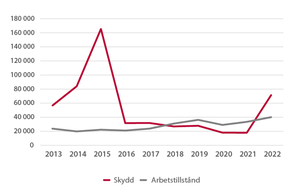 Zoom image
Zoom imageNumber of residence permits sought for protection and work 2013–2022. Press to enlarge. The lines represent protection (red) and work (grey).
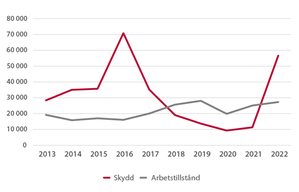 Zoom image
Zoom imageNumber of residence permits granted for protection and work 2013–2022. Press to enlarge. The lines represent protection (red) and work (grey).
Between 2013 and 2022, the composition of people who wanted to come to Sweden shifted from asylum seekers to employees and students. In somewhat simplified terms (and with the exception of the Temporary Protection Directive), in recent years about twice as many people have been granted work permits compared to asylum. In other words, more people are granted a work permit than are granted asylum.
From 2013 to 2022, more than 300,000 people were granted residence permits to work in Sweden. When it comes to employees, some come here for a seasonal job, while others come to Sweden to stay – and these statistics only show that they have been granted a residence permit. This also applies to students, who are even more involved in so-called "circular migration", which means that they usually leave the country once their studies are completed.
During the pandemic, all types of cases were affected by the travel restrictions, but especially those of employees and students. When it comes to employees, other factors and regulations affect the number and nationality of people who come to Sweden. These include the state of the economy, the attractiveness of other countries, and the availability of skills in Sweden and in other countries.
The number of students coming to Sweden has also increased, but at lower levels – from around 10,000 to just under 15,000 per year. One factor that has affected both employees and students is the requirement that applicants present their passport in person at an embassy or consulate-general.
What countries do people come from?
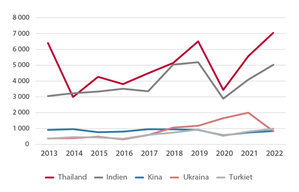 Zoom image
Zoom imageNumber of work permits granted per nationality 2013–2022. Press to enlarge.
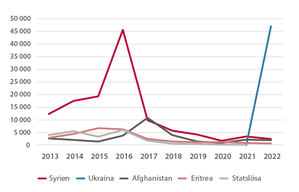 Zoom image
Zoom imageNumber of residence permits for protection granted per nationality 2013–2022. Press to enlarge
There are a number of reasons why people from various countries choose to come to Sweden. The situation in their country of origin, diaspora in Sweden, and Swedish legislation – these are just a few reasons why people of certain nationalities choose to come here. Of course, similar factors also affect the attractiveness of other recipient countries.
To get an indication of how this has developed during the period 2013–2022, the granted residence permits for protection (asylum, quota refugees, and the Temporary Protection Directive) are compared with granted work permits.
Of those who received protection in Sweden between 2013 and 2022, Syria was the predominant country of origin (with the exception of 2022, when Ukraine topped the list). Other major countries of origin during the period were Afghanistan, Eritrea, Iraq and Somalia.
During the same time span, Thailand, India, and China were the predominant countries of origin among those who came to Sweden to work. A great number of jobseekers have also arrived from Ukraine. A large proportion of Thais are seasonal workers, which means they come here for shorter periods than many other employees.
As has previously been mentioned in this article, two crucial trends during this period have been a decline in asylum seekers (with the exception of the war in Ukraine) and an increase in employees and students coming to Sweden. This has meant a shift in nationalities, from citizens of war-torn countries such as Syria and Afghanistan to those of developing economies like India and China. Last year, permits were granted to more employees from India than asylum seekers from Syria, Afghanistan and Eritrea combined (the largest refugee groups, after Ukraine, in 2022).
What’s next?
As has already been mentioned, Sweden’s share of persons seeking protection within the EU has decreased in recent years. Taking into account current legislation and the Government’s political reform agenda, the Swedish Migration Agency has assessed that this development will continue, despite unrest in the outside world. In areas other than asylum, policy is also leaning towards accepting fewer migrants into the country, rather than more. From October, there will be an increased maintenance requirement for labour migrants, as a result of which it is expected that fewer employees will come to Sweden.
-
The Swedish Migration Agency answers: How we work to detect security threats
As a result of the deteriorating security situation in the country, security, terror and threats to Sweden have dominated the social debate. Questions have been asked about what the Swedish Migration Agency does and how people with ties to terrorism get to Sweden in the first place. In this part of “The Swedish Migration Agency answers”, we go into more detail about how the agency works to detect and deal with people who may pose a security threat.
The Swedish Migration Agency has an obligation to assist the Swedish Security Service in its work to prevent and detect crimes against Sweden’s security, as well as in terrorism-related matters. Among other things, this means that the Swedish Migration Agency must be on the lookout for possible security threats in cases concerning residence permits and Swedish citizenship, in order to be able to inform the security service. The migration agency and the security service have collaborated very closely for many years and continuously exchange information within the context of the existing regulatory framework.
When information must be exchanged with the Swedish Security Service
Information and indications that may be of interest to the security service can be received by the migration agency in various ways. Such red flags are often raised in the course of the migration agency’s conversations with applicants, but can emerge in other ways too, e.g., via anonymous tips. The agency can also obtain information through submitted documents and passport documents or from staff working in the migration agency’s accommodations. The decisive factor is whether there are indications that the person may pose a threat to Sweden’s security – in which case the case must be presented to the security service. This means that we present the case to get guidance on how to proceed and give the security service the opportunity to decide whether it wants to take a closer look at it.
Some of the presented cases are sent to the security service for referral – in simple terms, this means that the migration agency asks the security service if there are any circumstances that affect the case and that concern Sweden’s security. In some cases, the security service requests the opportunity to make a statement about a case on its own initiative. Once their investigation is complete, they submit a statement to the migration agency. If the security service deems that the individual in question poses a security threat, they issue a so-called “objection” – this means, for example, that they propose that the migration agency reject the application for reasons relating to Sweden’s security.
What is a security case?
It is only when the Swedish Security Service issues a statement in a case and makes a formal objection concerning Sweden’s security or public security that the case formally becomes a security case, in accordance with the provisions of the Aliens Act or the Swedish Citizenship Act. All security cases are handled by a special unit at the Swedish Migration Agency. Even if the security service issues a statement in a case and suggests, for example, that a person should not be granted a residence permit or Swedish citizenship, it is the Swedish Migration Agency that ultimately takes an independent decision on the matter. However, the security service is the expert authority for assessing which persons may pose a threat to Sweden’s security. If the migration agency decides to reject an application, the applicant can appeal the decision.
It is important not to confuse security cases with cases involving suspicions of genocide, crimes against humanity, or war crimes. The Swedish Migration Agency has an obligation to report such crimes to the police, but this does not necessarily mean that they are security cases.
Qualified security cases
A person who is not a Swedish citizen may be expelled from Sweden in accordance with a special law, the Act concerning Special Controls of Certain Aliens, if the individual in question can be assumed likely to commit or otherwise contribute to a crime under the Terrorist Offences Act, or may constitute a serious threat to Sweden’s security. An expulsion application is filed by the security service, but it is the migration agency that examines and decides on the matter. According to this special legislation, the security service may also take other control measures against the individual.
Special liaison officers and specialists at the Swedish Migration Agency
The Swedish Migration Agency has special regional liaison officers and specialists who work with potential security cases.
The special liaison officers, known as SPoCs (Single Points of Contact), are responsible for regional contact with the Swedish Security Service and support the agency in individual cases, assisting case officers and decision-makers.
The regional specialists deal with cases involving exclusion and threats to public order and security and support the agency’s activities in these matters. Exclusion refers to cases in which a person seeking asylum can be excluded from being considered a refugee or a person eligible for subsidiary protection, if he or she can be suspected of having committed certain types of offences or criminal acts.
How can people who pose a security threat stay in Sweden?
In a separate statement, the Swedish Security Service may recommend that the applicant be refused entry or be expelled. This means they must leave Sweden. If the Swedish Migration Agency makes such a decision in a security case, it is the security service that is responsible for enforcing it. However, the fact that the migration agency issues an expulsion or refusal of entry decision does not always mean that the decision can be implemented – for example, this is impossible if the person could face the death penalty or torture, should they return to their country of origin. This creates a so-called “impediment to enforcement”.
If there are impediments to enforcement in a security case under the Aliens Act, the migration agency will issue a refusal of entry or deportation decision, but will simultaneously grant the applicant a temporary residence permit, which is usually valid for one year. Once that permit expires, the migration agency makes a new assessment of the impediment to enforcement and whether it is still relevant.
Statistics
How many cases are actually referred to the Swedish Security Service and how many formally become a security case? The statistics and charts provided here offer a clearer picture.
Referrals to the Swedish Security Service
Last year, the Swedish Migration Agency referred 296 residence permit cases and 788 Swedish citizenship cases to the security service. If you only look at residence permit cases, this figure has decreased every year since 2019. See the chart for more figures.
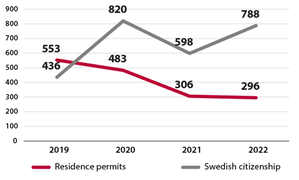 Zoom image
Zoom imageThe diagram shows how many cases concerning residence permits and Swedish citizenship that the Migration Agency has sent to the Security Service for referral during the years 2019–2022.
The number of security cases
Last year, the migration agency referred 160 residence permit cases and 490 Swedish citizenship cases to the security service. In 2019, 146 objections concerning citizenship applications were issued; in 2020 that figure was 100, while in 2021 it rose to 182.
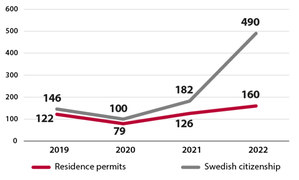 Zoom image
Zoom imageThe diagram shows the number of statements issued by the Swedish Security Service in cases concerning residence permits and Swedish citizenship between 2019 and 2022.
Relevant legislation
Section 5 of the Ordinance (2019:502) with Instructions for the Swedish Migration Agency states that the agency shall assist the Swedish Security Service in its activities aimed at preventing and detecting crimes against national security and in matters relating to terrorism.
Chapter 1, Section 7 of the Aliens Act and Section 27 of the Swedish Citizenship Act describe what constitutes a security case.
The Aliens Act (in Swedish)
 External link, opens in new window.
External link, opens in new window.The Swedish Citizenship Act (in Swedish)
 External link, opens in new window.
External link, opens in new window.Exclusion cases
Offences that can lead to a person’s exclusion from the right to asylum include war crimes and crimes against humanity.
Government mandates
The Swedish Security Service has a mandate from the Government to coordinate the long-term development of counter-terrorism efforts. This work is to be carried out within the context of the Counter-Terrorism Cooperative Council, in which the Swedish Migration Agency is one of the participating authorities.
Legislative proposals
In November, the Government submitted a proposal that, among other things, it should be possible to revoke a residence permit if it can be assumed that the individual in question will engage in state-run industrial espionage or activities tied to terrorism. The Government also proposes that it should be possible to revoke an alien’s passport for security reasons.
The amendments are proposed to come into force on 1 March 2024.
